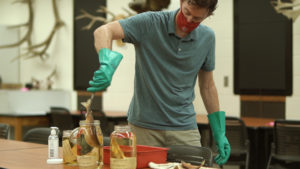In a concise and informative new video released today, Wisconsin Sea Grant illuminates the varied coregonines, commonly known as cisco, which have pulsed through Great Lakes waters for 12,000 years. Now, due to human influences, the fork-tailed fish are diminished in number and range, and display less diverse forms. They are the subject of a research project by a team at the University of Wisconsin-Madison.
“The ciscoes were some of the most numerous and populous fish in the Great Lakes,” said Ben Martin, Ph.D. student working with lead researcher Jake Vander Zanden who is the chair and director of the Center for Limnology. Martin noted ciscos’ importance as a food source for apex predators, both in the past and present-day.
To learn the future of the species, Vander Zanden is looking toward the past—exploring the fish found in dozens and dozens of jars that the video shows on rolling storage shelves housed at a zoology museum on the Madison campus.
“We go to these museum specimens. We take a tiny tissue sample. We take these chemical measurements, and we make these inferences about the diet and feeding of these species,” Vander Zanden said.

Jake Vander Zanden samples a museum specimen of a cisco to unlock details of the past Great Lakes food web. Photo by Bonnie Willison.
These fish that have been lifeless for 100 years will now breathe new life into an understanding of that past food web. Beyond analysis based on archived fish, samples from across the Great Lakes Basin, many from a collection at the University of Michigan in addition to the UW-Madison ones, Martin is assessing modern-day cisco morphometrics, that is, their physical diversity.
Pairing both types of knowledge contributes to ecological restoration. Vander Zanden said there is interest in bringing back ciscoes that feed higher predators. “We want to maximize our understanding of the past and hopefully use that as a guide (for restoration) moving forward.”
Sea Grant Videographer Bonnie Willison said, “As Jake, Ben and collaborators altered their research agenda during the pandemic, I had to alter the way I shoot video. We did virtual interviews and distanced filming to pull this off.”
She continued, “I was very intrigued by the problem of studying fish that don’t exist in the lakes anymore. I’m happy to profile this important study that will shed light on how to make positive changes in the lakes as they exist now.”
Martin and Vander Zanden stressed the value of collaboration on this project and expressed appreciation for colleagues at the U.S. Geological Survey, Great Lakes Fisheries Commission, University of Wyoming and U.S. Fish and Wildlife Service.





